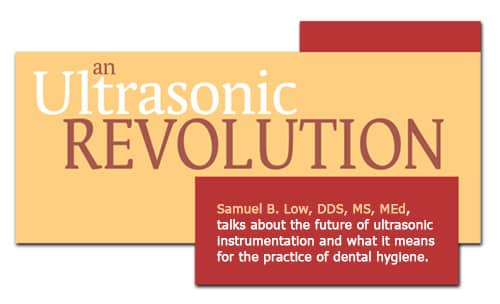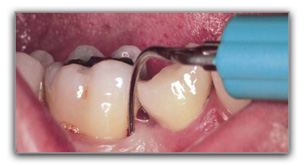
An Ultrasonic Revolution
Samuel L. Low, DDS, MS, MEd, discusses the future of ultrasonic instrumentation and what it means for the practice of dental hygiene.
Q. What do you think the future holds for ultrasonic instrumentation?
A. Ultrasonic instrumentation will be used in periodontal debridement procedures with far more frequency in the near future. This transformation is coming because we now understand why ultrasonic instrumentation works so well—it’s all in the disruption of the biofilm. Periodontal health cannot be achieved without the periodic removal or dissolution of established biofilm.1 Periodontal pathogens are negatively affected by ultrasonification.2 An ultrasonic unit used correctly with the appropriate diameter tip is probably the most effective strategy in removing biofilm during debridement. For the present, manual instrumentation still comes into play. For example, if a dental hygienist is using thin curettes, this may provide a level of synergy in the col area of the sulcus under the contact that would benefit from additional manual instrumentation. At this point, in order to ensure the quality of care and in considering the learning curve that still exists with using ultrasonic instrumentation, ultrasonic and manual instrumentation should be used in tandem with power driven instrumentation dominating the procedure.
| Table 1. Diameter of magnetostrictive inserts and corresponding procedures. | ||
| Insert category | Diameter at 5 mm from tip | Procedure indication |
| P 10 | 1.0 mm to 1.5 mm | Gross debridement |
| P 50 | 0.5 mm to 0.8 mm | Gingival debridement
Periodontal debridement |
| P 100 | <0.5 mm | Periodontal debridement |
Q. What diameter of tip is best?
A. In periodontal debridement, the last 3 mm of the tip must be 0.5 mm or less in diameter, which is approaching the size of a periodontal probe, in order to be effective (See Figure 1). Otherwise, the device is not acceptable for any other type of instrumentation with the exception of gross debridement (See Table 1 for a listing of tip diameters and their corresponding procedures).
 |
| Figure 1. A thin diameter ultrasonic tip in a periodontal pocket. |
Q. Why is the tip diameter so important?
A. Access is key to effective instrumentation and without a small tip, achieving the access necessary for effective instrumentation is impossible. For example, if a dental hygienist uses a periodontal probe that is 1 mm in diameter, and then did the same probing with a tip that is 0.5 mm in diameter, the probing depths are radically different. Proper access is only achieved with thin instrumentation.
Q. Do the differences in ultrasonic units have any effect on instrumentation?
A. Compared to tip size, the differences in generator equipment are not as critical in results. The competency of the clinician, especially in the knowledge of root anatomy, is more important. With equipment, the thinner the tip, the more important the generator is because the generator must compensate for the tip’s fragility or tip breakage or root damage will occur. In regards to new developments in inserts, the addition of self-aspiration would be valuable. Aerosol control would be a welcome addition that would assist the clinician with asepsis and access.
FULL MOUTH DISINFECTION
Q. Is full mouth disinfection effective?
A. Studies demonstrate the validity of full mouth disinfection.3 A stratification of biofilms exists, and the deeper the pocket depth, the more pathogenic the organisms.4 We know that bacteria are not only in the sulcus, but are also traveling around in the saliva. It is possible that they move around in the oral cavity from site to site. This suggests that the traditional single session quadrant root planing may not have biologic significance. Total mouth disinfection may have a role to play. Beginning new patient debridement with a gross ultrasonic debridement and repeating at every debridement appointment may make a difference. The dental hygienist may want to concentrate on one or two quadrants at an appointment but starting with a 10 minute disinfection of all sulci with an ultrasonic first could make a difference biologically.
CLINICAL AND POLITICAL CONSIDERATIONS
Q. Do you foresee any problems with this move toward ultrasonic instrumentation?
A. Yes, ultrasonic instrumentation is not effective and can even be harmful if the clinician is not skilled in technique. Some clinicians do not appreciate that debridement with ultrasonic instrumentation is an art. Unfortunately, an area that is crucial to clinicians developing exemplary technique is root anatomy and dental and dental hygiene debridement curriculums must focus on this concept. Understanding root anatomy is key to being able to remove biofilm from every nook and cranny of the tooth. Dental hygienists who are very thorough, understand root anatomy, and who perform instrumentation with small diameter tips, probably have less reoccurrence of disease than hygienists who do not possess knowledge of root anatomy.
There is a significant difference in providing debridement for gingivitis patients vs periodontitis patents. Scope of practice should not be based on supra- versus subgingival access but on the initial diagnosis of gingivitis vs periodontitis.
REFERENCES
- Sbordone L, Ramaglia L, Guletta E, Iacono V. Recolonization of the subgingival microflora after scaling and root planing in human periodontitis. J Periodontol . 1990;61:579-584.
- Baehni P, Thilo B, Chapuis B, Pernet D. Effects of ultrasonic and sonic scalers on dental plaque microflora in vitro and in vivo. J Clin Periodontol . 1992;19:455-459.
- De Soete M, Mongardini C, Peuwels M, Haffajee A, et al. One-stage full-mouth disinfection. Long-term microbiological results analyzed by checkerboard DNA-DNA hybridization. J Periodontol . 2001;72:374-382.
- Socransky SS, Haffajee AD. Periodontal microbial ecology. Periodontol 2000 . 2005;38:135-187.
From Dimensions of Dental Hygiene. July 2006;4(7): 24, 26.

